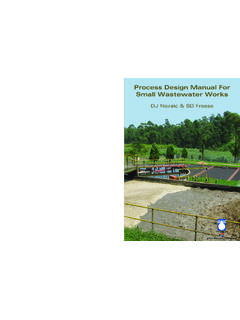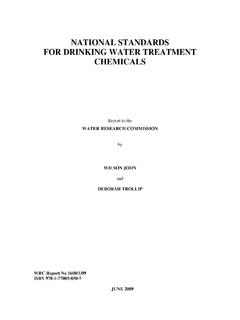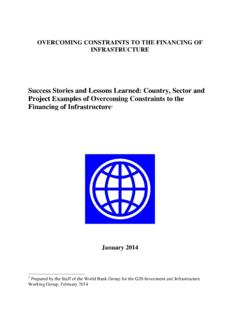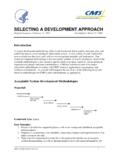Transcription of REVIEW OF SANITATION POLICY AND PRACTICE IN …
1 REVIEW OF SANITATION POLICY AND PRACTICE IN SOUTH AFRICA FROM 2001-2008 Report to the Water research Commission by Nozibele Mjoli Hlathi Development Services WRC Report No. 1741/1/09 ISBN 978-1-77005-899-6 March 2010 ii DISCLAIMER This report has been reviewed by the Water research Commission (WRC) and approved for publication. Approval does not signify that the contents necessarily reflect the views and policies of the WRC, nor does mention of trade names or commercial products constitute endorsement or recommendation for use. iii EXECUTIVE SUMMARY Background and motivation The South African Democratic Government has prioritised the provision of basic water and SANITATION services to the poor because of the perceived high impact of these services in the reduction of poverty. In 2001 an estimated of the population had access to basic or higher level of SANITATION services and lacked access to a basic SANITATION service level (Census 2001).
2 Between 2001 and 2008, approximately 73% of the population had access to basic SANITATION services and the basic SANITATION backlog was reduced to 27% (DWAF, 2008). This represented significant progress in the eradication of the basic SANITATION infrastructure backlog. The 2010 target for the eradication of the basic SANITATION infrastructure backlog set by the Strategic Framework for Water Services in 2003 has forced all spheres of government to allocate more resources to support the acceleration of basic SANITATION infrastructure delivery to all those households who currently lack access to these services. In spite of all these efforts, there were, however, still millions of households that lacked access to a basic SANITATION service level. A study conducted by DWAF (2005) to audit the sustainability of the SANITATION projects implemented from 1994-2003 found that a significant number of these projects were not sustainable.
3 This problem of poor sustainability could be due to a lack of common understanding and interpretation of the national SANITATION POLICY by municipalities and other implementing agents. The Water research Commission initiated this study to examine the understanding and interpretation of the national SANITATION POLICY and programme by municipalities and to identify aspects of the POLICY that were poorly understood and/or misinterpreted and to make recommendations for bridging the gap between POLICY and PRACTICE . The study used the definition of a basic SANITATION service provided in the Strategic Framework for Water Services (2003): a basic SANITATION service is the provision of a basic SANITATION facility which is easily accessible to a household, the sustainable operation of the facility, including the safe removal of human waste and wastewater from the premises where this is appropriate and necessary, and the communication of good SANITATION , hygiene and related PRACTICE .
4 Questions have been raised on the appropriateness of a single national SANITATION POLICY for the different settlement types (formal urban, dense urban informal and rural settlements). Our working hypothesis was that the SANITATION POLICY principles of the 2001 White Paper on Basic Household SANITATION were appropriate and relevant to formal urban, dense urban informal and rural settlements; the only variable was how these principles were interpreted under the different local contexts. Objectives The main objectives of the study were the following: To investigate the understanding of current SANITATION POLICY and programmes relating to the subsidy, ownership of infrastructure, responsibility for O&M, responsibility for monitoring issues of new pits, etc. amongst: National government departments; Local government; iv Service providers; Communities. To provide recommendations for bridging understanding on POLICY , responsibilities and PRACTICE .
5 Compilation of information pamphlets for each stakeholder group that provide a common approach to the issues of ownership, responsibility for O&M and dealing with full pits (for VIPs, Urine Diversion and other on-site latrines). Achievement of objectives The study has achieved the objectives of the study and it produced the following research outputs: A research report with recommendations for bridging the gap between POLICY and PRACTICE . SANITATION POLICY recommendations Information booklet for SANITATION POLICY -makers (Appendix A). Turning SANITATION POLICY into PRACTICE A guide for municipalities and SANITATION service providers (published as a separate brochure). Methodology i) Desktop analysis Literature REVIEW of international and national experience was conducted to identify international best PRACTICE in the provision of pro-poor SANITATION subsidies.
6 The examination of the understanding and interpretation of the SANITATION POLICY and programme was based on the analysis of the White Paper on Basic Household SANITATION (DWAF, 2001) and the Strategic Framework for Water Services (DWAF, 2003). ii) Stakeholder engagement Face-to-face interviews were conducted with SANITATION sector stakeholders and a survey of 17 District Water Services in three provinces was undertaken to assess the understanding and interpretation of the SANITATION POLICY by municipalities. iii) The recommendations for bridging the gap between SANITATION POLICY and PRACTICE were made based on international best PRACTICE on sustainable SANITATION services and inputs from SANITATION sector stakeholders. iv) The findings from the study were used to prepare the information booklets for SANITATION POLICY -makers and municipalities. Key findings from the research International experience of pro-poor SANITATION policies The literature REVIEW identified improvement in health, affordability, environmental sustainability and management of SANITATION services at the lowest appropriate levels as four fundamental principles of sustainable SANITATION programmes.
7 V International experience of subsidized SANITATION programmes showed that supply-driven SANITATION delivery approaches led to unsustainable SANITATION services because they focused on toilet construction without considering hygiene education, community mobilisation and meeting SANITATION demands of the beneficiary communities. Adoption of a Community Led Total SANITATION (CLTS) approach resulted in a rapid increase in SANITATION coverage in South Asia and India after decades of failed supply-driven toilet construction programmes. The success of this approach was possible because the local communities took the lead in ensuring that their villages were open defecation free and they used peer pressure to enforce compliance by all households. An international REVIEW of successful case studies of pro-poor SANITATION subsidies showed that good water and SANITATION pro-poor subsidies were characterized by genuine need, accurate targeting of the poor, administrative simplicity, preservation of economic incentives and coverage.
8 An analysis of case studies of the implementation of the national SANITATION policies in Uganda and Zimbabwe demonstrated that good policies were not enough to achieve sustainable SANITATION coverage in the absence of capacitated local government institutions. Analysis of the understanding and interpretation of the national SANITATION POLICY The study identified the following aspects of the SANITATION POLICY that were misunderstood and/or misinterpreted by the municipalities: Access to basic SANITATION service as a human right There was no common approach to the interpretation of this principle; some municipalities were providing free basic SANITATION (FBSan) services to all households connected to the sewer networks while others were limiting FBSan services to registered indigent households. Targeting the poor with SANITATION subsidies There were no national guidelines for identifying the poorest households; municipalities were using different methods to target FBSan services to the poor households.
9 Integration of health and hygiene education into basic SANITATION services There was too much focus on toilet construction with limited attention paid to the health and hygiene education component and limited or no budgets were allocated to this component. Grey water management in dense settlements Although the definition of a basic SANITATION service included wastewater disposal, in PRACTICE municipalities were not providing facilities for safe disposal of wastewater in dense urban informal settlements without connections to sewer networks. Solid waste disposal The 2001 White Paper on Basic Household SANITATION includes refuse removal in its definition of a minimum acceptable basic level of SANITATION but in PRACTICE refuse removal was not included as a component of basic SANITATION . Long-term sustainability of ventilated improved pit toilets Most municipalities did not have O&M plans for emptying full pits of VIP toilets and disposal of human waste; this could pose a threat to long-term sustainability of VIP toilets.
10 Integration of water conservation and water demand management There was no enforcement of the use of water efficient technologies when full waterborne SANITATION systems were provided to meet the basic SANITATION needs of poor households. vi Monitoring and evaluation Monitoring and evaluation of progress in the implementation of the SANITATION POLICY and its impact on the lives of poor households was limited to the counting of toilets and number of jobs created. There was no monitoring of behavioural change and evaluation of the impact of improved SANITATION infrastructure on the quality of life and health of the beneficiary communities. SANITATION POLICY gaps The following SANITATION POLICY gaps were identified: Lack of SANITATION POLICY guidelines for basic SANITATION service delivery to dense urban informal settlements. No SANITATION POLICY guidelines for the provision of basic SANITATION services to severely marginalized groups such as people with physical disabilities, elderly, women, children, HIV/AIDS infected individuals and child-headed households.


















